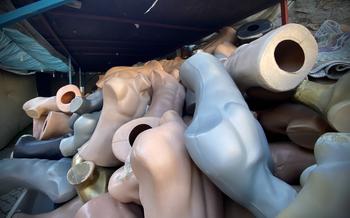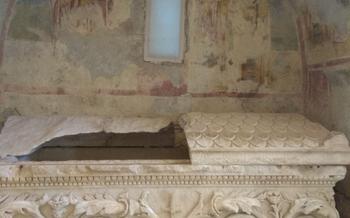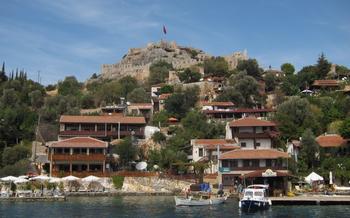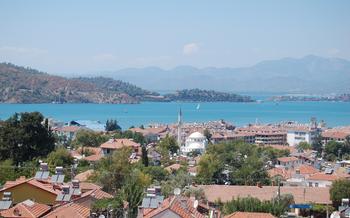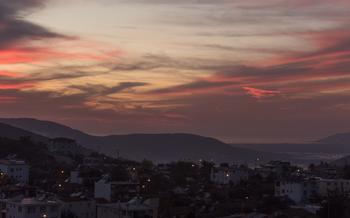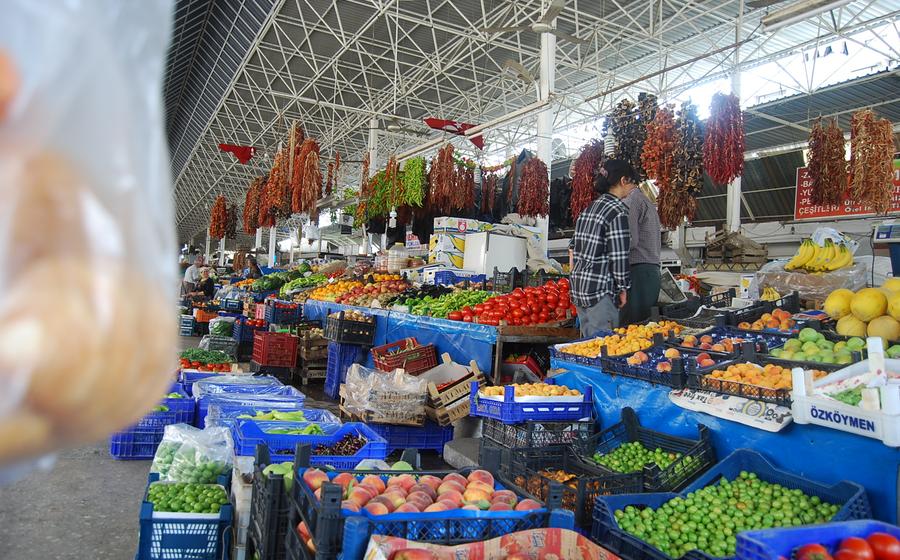
Lycian Rock Tombs in Myra
- History of the Lycian Rock Tombs
- Location of the Rock Tombs
- Architectural Features
- Chamber Tombs
- Temple Tombs
- Carvings and Ornamentation
- Comparison with Other Tombs
- Preservation and Conservation
- Myra's Amphitheater: A Stage of History
- The Church of St. Nicholas
- The Temple of Artemis
- The Lycian Way Hiking Trail
- Local Cuisine and Restaurants
- Shopping and Handicrafts
- Accommodation Options
- Budget and Cost Considerations
- Family-Friendly Activities
- Photography Tips
- Insider Tip: Unveiling the Hidden Beauty of Myra
History of the Lycian Rock Tombs
The Lycian civilization, known for its maritime prowess and cultural achievements, flourished in the region of ancient Anatolia, present-day Turkey, from the 5th century BC to the 2nd century AD. The Lycians were skilled sailors and traders, establishing a vast network of commercial and cultural exchanges across the Mediterranean. Myra, one of the prominent Lycian cities, was a significant port and administrative center.
The Lycian Rock Tombs, carved into the sheer cliffs overlooking the ancient city of Myra, stand as testaments to the Lycians' architectural ingenuity and funerary practices. These elaborate tombs were not merely burial chambers but also served as expressions of the Lycians' beliefs and cultural identity. The tombs' facades, adorned with intricate carvings and iconography, reveal insights into the Lycian worldview, their reverence for their ancestors, and their aspirations for the afterlife.
Location of the Rock Tombs
The Lycian Rock Tombs are situated in the picturesque town of Myra, nestled within the province of Muğla in southwestern Turkey. This ancient city, once a prominent member of the Lycian League, lies approximately 120 kilometers southeast of the popular tourist destination of Fethiye and can be conveniently reached by road.
To immerse yourself in the allure of Myra and its rock tombs, you can embark on a scenic drive along the winding roads that traverse the stunning Turkish countryside. Alternatively, if you prefer a more leisurely approach, opt for a guided tour that will transport you to this historical site, providing insightful commentary along the way.
Myra's proximity to other captivating historical landmarks and tourist attractions makes it an ideal base for exploring the region's rich heritage. The awe-inspiring ancient city of Xanthos, renowned for its well-preserved ruins and intricate rock-cut tombs, is just a short distance away. Additionally, the picturesque coastal town of Demre, where the legendary Saint Nicholas once resided, is within easy reach, inviting you to delve into its captivating history.
Whether you choose to drive, join a tour, or explore independently, the journey to Myra promises an unforgettable adventure through Turkey's captivating landscapes, leading you to the doorstep of the Lycian Rock Tombs, where history and nature intertwine to create a truly mesmerizing spectacle.
Architectural Features
The Lycian rock tombs are renowned for their unique architectural features, reflecting the artistic prowess of the ancient Lycians. These tombs vary in design, ranging from simple chamber tombs to elaborate temple tombs.
Chamber Tombs
The chamber tombs are the most common type, featuring a single chamber carved into the rock face. These chambers are typically accessed through a small entrance, and they may contain multiple burial niches or sarcophagi.
Temple Tombs
The temple tombs are more elaborate and resemble miniature temples. They often feature a portico with columns, a pediment, and a frieze decorated with intricate carvings. The interiors of these tombs are typically larger and may contain multiple chambers or niches.
Carvings and Ornamentation
The facades of the Lycian rock tombs are adorned with exquisite carvings and ornamentation. These carvings depict a variety of motifs, including human figures, animals, plants, and mythical creatures. The symbolism and iconography found on these facades provide valuable insights into the beliefs and culture of the Lycian civilization.
Comparison with Other Tombs
In comparison with other ancient tombs in the region, the Lycian rock tombs stand out for their unique architectural style and elaborate ornamentation. While other tombs, such as the Phrygian tombs in Afyonkarahisar or the Paphlagonian tombs in Bartın, share similarities in terms of their rock-cut nature, the Lycian tombs are distinguished by their intricate carvings and temple-like design.
These tombs have also been compared to the Petra tombs in Jordan, which share some similarities in terms of their rock-cut architecture. However, the Petra tombs are generally larger and more elaborate, with intricate facades and interiors carved directly into the sandstone cliffs.
Preservation and Conservation
The Lycian Rock Tombs in Myra, Turkey, are a testament to the rich cultural heritage of the Lycian civilization. Preserving and conserving these ancient wonders is of utmost importance to protect their historical significance and ensure their longevity for future generations.
Efforts are underway to conserve and restore the rock tombs, addressing various challenges, including erosion, weathering, and the impact of tourism. Conservationists use techniques such as cleaning, stabilization, and documentation to safeguard the structural integrity and authenticity of the tombs.
Responsible tourism plays a crucial role in preserving the site. Visitors are encouraged to follow designated paths, avoid touching or climbing on the tombs, and refrain from graffiti or vandalism. By respecting the site and adhering to responsible practices, tourists can contribute to the long-term preservation of these ancient treasures.
Ongoing research and documentation contribute to the understanding and preservation of the Lycian Rock Tombs. Archaeological studies, 3D scanning, and historical research provide valuable insights into the construction methods, cultural significance, and iconography of these unique monuments.
The preservation and conservation of the Lycian Rock Tombs in Myra are essential to maintaining their cultural and historical value. Through collaborative efforts, responsible tourism practices, and ongoing research, we can ensure that these ancient wonders continue to inspire and captivate visitors for generations to come.
Myra's Amphitheater: A Stage of History
In the heart of ancient Myra, nestled amidst the Lycian rock tombs, stands an impressive amphitheater, a testament to the city's grandeur and cultural significance. Carved into the natural slope of the hillside, this architectural masterpiece served as a vital entertainment and assembly venue for the Lycians, hosting a variety of events that shaped the social and cultural fabric of their civilization.
The amphitheater's imposing structure boasts a well-preserved seating area capable of accommodating thousands of spectators. Tiered rows of stone seats rise steeply from the orchestra, providing an unobstructed view of the central performance space. The stage, adorned with intricate carvings and decorative elements, once played host to theatrical productions, musical performances, and gladiatorial contests, keeping the citizens of Myra enthralled and entertained.
Beyond its entertainment value, the amphitheater served as an important civic and political center. Public assemblies, debates, and political speeches took place within its walls, allowing the Lycians to engage in the governance of their city. The amphitheater's acoustics, carefully designed to amplify the voices of speakers, ensured that every word reached the far corners of the venue, fostering a sense of unity and participation among the citizens.
Myra's amphitheater stands as a remarkable example of ancient architectural prowess, blending functionality with aesthetics. Its enduring presence serves as a reminder of the vibrant cultural heritage of the Lycians and invites visitors to step back in time, imagining the sights, sounds, and emotions that once filled this extraordinary space.
The Church of St. Nicholas
The Church of St. Nicholas, situated in the heart of ancient Myra, stands as a testament to the city's rich religious heritage. Dedicated to the revered Saint Nicholas, the church holds immense historical and spiritual significance.
St. Nicholas, also known as Santa Claus, was a 4th-century bishop of Myra who was renowned for his generosity and kindness. The church, built in his honor, is believed to date back to the 6th century and has undergone several renovations and expansions over the centuries.
The architectural style of the church is a blend of Byzantine and Gothic influences, showcasing intricate stonework and beautiful frescoes depicting scenes from the life of St. Nicholas. The interior features a spacious nave, adorned with columns and arches, leading to a sanctuary where the altar once stood.
Pilgrims and tourists from around the world flock to the Church of St. Nicholas to pay homage to the saint and seek his blessings. The church remains an active place of worship, and visitors can attend mass or simply soak in the tranquil atmosphere and admire its historical grandeur.
The connection between St. Nicholas and the legend of Santa Claus is particularly intriguing. It is believed that the tradition of gift-giving associated with Santa Claus originated from the stories of St. Nicholas' generosity. His reputation for helping the poor and needy, especially children, led to his association with the figure of Santa Claus, who brings gifts to children on Christmas Eve.
Visiting the Church of St. Nicholas offers a unique opportunity to explore the life and legacy of this beloved saint. The church's historical significance, combined with its spiritual aura, makes it a must-visit destination for anyone interested in history, religion, or the origins of the Santa Claus legend.
The Temple of Artemis
The Temple of Artemis, also known as the Artemision, was a significant religious site in ancient Myra. Dedicated to the Greek goddess Artemis, who was revered as the protector of nature and wildlife, the temple held a prominent position within the city's religious landscape. Constructed in the 4th century BC, it showcased the architectural prowess of the Lycians and served as a testament to their devotion to the divine.
The temple's architecture exuded elegance and grandeur. Built using locally quarried limestone blocks, it featured a rectangular design with a pronaos (porch) supported by Ionic columns. The interior of the temple housed a cella (inner chamber) where a statue of Artemis, crafted with intricate detail, was enshrined. The temple's facade was adorned with exquisite carvings depicting scenes from Greek mythology, showcasing the Lycians' mastery of artistic expression.
Artemis, known as the protector of wild animals, was deeply revered in Myra. The temple served as a focal point for religious ceremonies, festivals, and rituals dedicated to the goddess. Devotees from across the region flocked to the temple to pay homage to Artemis, seeking her blessings and protection. The temple's enduring legacy as a sacred site speaks volumes about the profound spiritual connection the Lycians felt with their deities.
The Lycian Way Hiking Trail
The Lycian Way, a world-renowned hiking trail, meanders through the stunning landscapes of Turkey's Turquoise Coast, offering trekkers an unforgettable journey into history and nature. As you embark on this 509-kilometer trail, you'll traverse ancient ruins, encounter breathtaking vistas, and soak in the tranquility of the Mediterranean wilderness.
Passing through the heart of Myra, the Lycian Way grants hikers the opportunity to explore the ancient city and its iconic rock tombs up close. Admire the intricate carvings that adorn the facades of these elaborate tombs, each telling a unique story of the Lycian civilization. Marvel at the ingenuity of the Lycians, who carved these impressive structures into the sheer rock face over two millennia ago.
The Lycian Way offers a diverse range of hiking experiences, from easy coastal paths to challenging mountain trails. Walk alongside turquoise waters, climb through fragrant pine forests, and traverse rugged terrain that reveals panoramic views of the Mediterranean Sea. Along the way, you'll encounter ancient ruins, charming villages, and friendly locals who will welcome you with open arms.
To fully immerse yourself in the Lycian experience, plan your hike during the shoulder seasons (April-May and September-October) when the weather is pleasant and the crowds are smaller. Remember to pack sturdy hiking boots, comfortable clothing, and plenty of water, as the trail can be strenuous in some sections.
Whether you're a seasoned hiker or a nature enthusiast seeking a unique adventure, the Lycian Way offers an unforgettable journey through history, culture, and breathtaking landscapes. Lace up your boots, embrace the challenge, and discover the wonders that await you on this iconic trail.
Local Cuisine and Restaurants
The culinary traditions of the Muğla region are a blend of Turkish, Mediterranean, and Aegean influences. Fresh seafood, locally grown produce, and aromatic herbs are the cornerstones of the local cuisine. Myra offers a range of dining options, from traditional Turkish restaurants to charming cafes and family-run tavernas.
For an authentic Turkish experience, try the "meze" platters, an array of small dishes that showcase the region's flavors. Sample "köfte," grilled meatballs, or "dolma," stuffed grape leaves, accompanied by freshly baked bread. For seafood lovers, the "guvec," a clay pot dish with fish, vegetables, and herbs, is a must-try.
Vegetarians will delight in the variety of "meze" dishes, as well as dishes like "imam bayıldı," roasted eggplants stuffed with tomatoes, onions, and herbs. Local wines from the Muğla region are a great accompaniment to your meal.
To get the most out of your culinary journey, venture beyond the main tourist areas and explore the local markets. Here, you'll find fresh fruits, vegetables, spices, and traditional sweets. Engage with the locals, learn about their culinary traditions, and pick up some ingredients to create your own Turkish feast.
Shopping and Handicrafts
Myra offers a delightful opportunity for visitors to delve into the vibrant world of Turkish craftsmanship and bring home unique souvenirs. From intricately handwoven carpets to meticulously crafted pottery, the local markets and shops showcase the region's rich cultural heritage. Explore the stalls filled with colorful textiles, intricate jewelry, and decorative objects made from traditional materials like copper, wood, and leather.
When seeking authentic souvenirs, be sure to look for items made using traditional techniques, such as hand-loomed rugs or hand-painted ceramics. These pieces not only make for beautiful mementos but also support local artisans and the local economy.
Visit the Myra Bazaar, held weekly in the town square, to experience the lively atmosphere and find a diverse range of handicrafts. Here, you can witness skilled artisans demonstrating their craft and gain insights into the local culture.
Remember, bargaining is a common practice in Turkish markets, so don't hesitate to engage in friendly negotiations to get the best prices. The shopkeepers are usually open to bargaining and may even offer discounts for multiple purchases.
Shopping in Myra is not just about acquiring souvenirs but also about immersing yourself in the local culture and supporting the talented artisans who keep these traditions alive.
Accommodation Options
When planning your visit to the Lycian Rock Tombs in Myra, you will have a range of accommodation options to choose from. Whether you prefer the comfort of a hotel, the charm of a guesthouse, or the authenticity of a homestay, you will find something to suit your needs and budget.
For a luxurious stay, the nearby town of Demre offers several upscale hotels with stunning views of the Mediterranean Sea. These hotels often feature amenities such as private balconies, swimming pools, and spas.
If you prefer a more budget-friendly option, there are several guesthouses and hostels in the area that offer clean and comfortable accommodations at a fraction of the cost. These guesthouses often have a friendly atmosphere and provide an excellent opportunity to interact with other travelers.
For those seeking a truly immersive experience, homestays are available in the local villages. Staying with a local family is a wonderful way to learn about Turkish culture and traditions. Homestays typically offer basic accommodations, but the warm hospitality and delicious home-cooked meals more than make up for any lack of amenities.
No matter which type of accommodation you choose, be sure to book in advance, especially if you are visiting during the peak tourist season. This will ensure that you have a place to stay and avoid any last-minute surprises.
Budget and Cost Considerations
Visiting the Lycian Rock Tombs and other attractions in Myra is generally affordable, making it accessible to travelers of all budgets. The entrance fee to the site is minimal, and there are various options to keep costs low. Transportation expenses depend on your chosen mode of travel, with local buses and shared taxis offering budget-friendly options. Accommodation costs vary based on your preferences; there are budget-friendly guesthouses and homestays, as well as mid-range hotels for those seeking more amenities.
Food expenses can be managed by trying local restaurants and opting for traditional Turkish dishes, which are often reasonably priced. For a truly immersive experience, consider staying in a local village or town, where you can find authentic accommodations and meals at a lower cost. Take advantage of local markets for fresh produce, cheese, and bread to save on dining expenses.
Remember, the value of visiting Myra and the surrounding area goes beyond financial considerations. The rich history, stunning natural beauty, and cultural experiences make it a worthwhile destination for budget-conscious travelers seeking an enriching and memorable journey.
Family-Friendly Activities
Visiting the Lycian Rock Tombs in Myra can be a great educational and enjoyable experience for families with children. The site offers a unique blend of history, nature, and exploration that can spark curiosity and imagination in young minds.
One of the most engaging activities for kids is to explore the rock tombs and imagine what life was like for the ancient Lycians. They can pretend to be archaeologists discovering hidden treasures or play a game of hide-and-seek among the ruins.
To make the visit more interactive, parents can bring along books or educational materials about the Lycians and their culture. They can also encourage children to take notes or draw sketches of what they see, creating a personalized travel journal or scrapbook.
Another great way to engage kids is to organize a scavenger hunt or treasure hunt around the site. Create a list of items for them to find, such as a specific architectural feature, a plant, or a hidden symbol, and have them race to be the first to complete the list.
For a more hands-on experience, families can visit the nearby workshops or studios where local artisans demonstrate traditional crafts such as pottery, weaving, or jewelry making. Children can try their hand at these activities and create their own souvenirs to take home.
By incorporating these interactive and educational elements, families can turn their visit to the Lycian Rock Tombs into a memorable and enriching experience for everyone.
Photography Tips
The Lycian Rock Tombs offer a feast for the eyes and a perfect opportunity to capture stunning photographs. To make the most of your photographic experience, consider the following tips:
- Best Angles and Lighting:
-
For the best shots, visit during the golden hours (sunrise and sunset) when the warm light illuminates the facades and enhances the details of the carvings. The soft morning light is particularly suitable for capturing the intricate artistry of the tombs.
-
Panoramic Shots:
-
Take advantage of the elevated vantage points to capture breathtaking panoramic shots of the rock tombs nestled amidst the surrounding landscape.
-
Details and Close-ups:
-
Don't forget to capture close-up shots of the intricate carvings and ornamentation on the facades. These details often reveal hidden stories and symbols.
-
Editing and Filters:
-
Utilize photo editing software or filters to enhance the colors and contrast of your images, making them even more vivid and visually appealing.
-
Respect and Courtesy:
- Always be mindful of other visitors and avoid blocking their views or disturbing their experience while taking photographs.
Insider Tip: Unveiling the Hidden Beauty of Myra
Beyond the well-trodden paths of Myra, a secret viewpoint awaits those willing to venture off the beaten track. Nestled amidst the rolling hills that embrace the ancient city, this hidden gem offers a breathtaking panorama that captures the essence of Lycian grandeur. As the sun dips below the horizon, the rock tombs are bathed in a warm golden glow, casting long shadows that dance across the landscape.
For an unforgettable experience, plan your visit to coincide with the annual Myra Festival, held every summer. This vibrant celebration brings the ancient city to life with traditional music, dance performances, and reenactments of historical events. Immerse yourself in the rich cultural heritage of Myra as you witness the Lycian legacy come alive before your eyes.
If you seek a unique perspective on the rock tombs, consider embarking on a guided sunrise tour. As the first rays of sunlight illuminate the site, the intricate carvings and ornamentation on the facades are revealed in all their glory. With fewer visitors at this time of day, you can savor the tranquility and capture stunning photographs without the crowds.
To fully appreciate the grandeur of the Lycian civilization, venture beyond the rock tombs and explore the nearby ruins of the ancient city of Myra. Wander through the remnants of temples, theaters, and other structures, each whispering tales of a bygone era. With a little exploration, you'll uncover hidden corners and lesser-known gems that will leave you in awe of the Lycian's architectural prowess.
